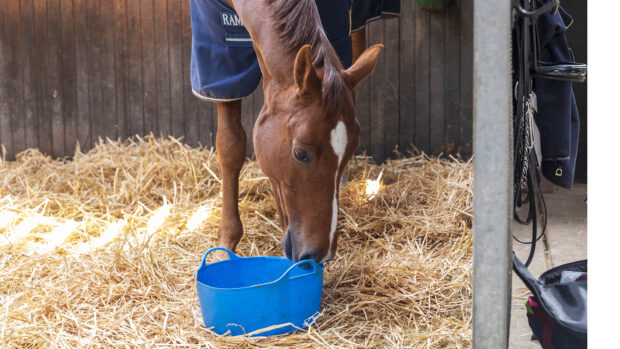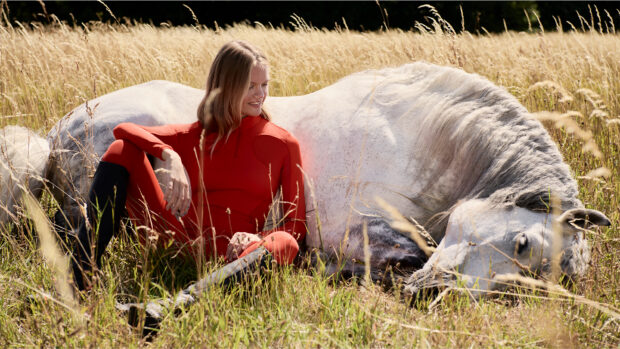With the UK enjoying some warmer weather this week, H&H asks the experts how best to help horses and their riders cope in hot temperatures with their advice on riding in hot weather.
When is it too hot to ride?
Emmeline Hannelly, welfare education manager at The British Horse Society (BHS), says: “If you are going to ride, it is best to do so either in the morning or evening when it is coolest. If you are riding in warmer weather, take more breaks in-between different exercises – horses can’t be expected to do as much in hot weather as they would at other times if they are not acclimatised to working for longer periods in the heat.
“Be mindful of your horse’s fitness as overweight horses may struggle more in hot weather. After riding, make sure you cool the horse down properly. This can be achieved by continuously pouring water all over the horse’s body surface.”
What are the signs of dehydration and what should you do if you are concerned?
Emmeline says: “The single most important thing is to keep your horse hydrated. Horses can easily consume more than double their normal water intake in hot weather, so be prepared for this.
“Knowing what is normal for your horse is important so you know when your horse isn’t right. Signs of dehydration in horses include lethargy, depression, poor performance, thick and sticky saliva, mucous membranes that become redder in colour, increased pulse and breathing rate, nostril flaring, decreased appetite, producing dark urine or not passing urine for long periods of time.
“Feeding electrolytes can help replace those lost through sweating. But if you are adding them to water, make sure the horse doesn’t mind the taste, because if it puts him off he may not drink anything at all, so always offer an electrolyte-free option.

Science Supplements Complete Electrolytes
Available as a daily supplement or instant syringe, these highly palatable, fully balanced electrolytes replace those lost during exercise while being gentle on digestion, too.

Equine America Apple Lytes
These apple and cherry flavour electrolytes provide a careful balance of sodium, potassium, chloride, calcium and magnesium, while promoting drinking and rehydration.
“If dehydration isn’t acted on, this could lead to heat exhaustion and potentially heat stroke which is extremely serious. If you are concerned for your horse, move him somewhere cool to rest and offer him water. Allow your horse to graze if possible and monitor their pulse and breathing rate. If your horse does not show signs of improvement, contact your vet immediately.
“If you are travelling your horse anywhere, take more water with you than you think you will need. Remember some horses are fussy about drinking water away from home, so it could be essential to have a familiar supply.”

25l Water Container | Amazon
Taking water with you on your travels is essential, and water containers are useful all year round.
Is water alone enough to rehydrate a horse?
Dr Francesca Compostella DVM, MRCVS, MSc, the RSPCA’s equine senior clinician, explains: “Water makes up approximately 70% of a horse’s body, so plenty needs to be available to maintain such levels. Horses absorb water through food and from drinking. On average, a horse should intake between 25-50 litres of water per day. So, during the hot weather, ensure they always have access to plenty of clean water.
“Water alone however may not be enough, as the fluid component of our bodies also contain important electrolytes that are responsible for keeping our blood pressure and cell and nerve functions active.
“Your horse could lose vast amounts of electrolytes by sweating, but normally these are replenished in the feed. If, however, he or she is sweating more than they can replenish, supplementary electrolytes can be administered.
“There are a number of commercially available powders, which are diluted in the water for your horse to drink. These have additives which are appealing to horses, such as apple flavours.
“Rehydrating solutions can also be made at home using 1.5tbsp of salt and 2tbsp of sugar in 4L of water. Amino acids such as glutamine can be added. It is, however, easier and most reliable to invest in a tub of commercially available electrolytes, which are easy to store and have a very long shelf date.”

Equine America Apple Lytes
These apple and cherry flavour electrolytes provide a careful balance of sodium, potassium, chloride, calcium and magnesium, while promoting drinking and rehydration.
Help – I’m competing. How can I help keep my horse cool?
Dr Francesca Compostella says: “The body’s mechanism to release heat and thereby cool down, is by sweating. During water loss, the heat is lost to the environment in a mechanism called convection.
“To help your horse cool down, hose them with cool water, let them stand in a shaded, well ventilated area and ensure there is drinking water available. Don’t use wet towels or fabric covers over your horse, as these prevent the convection of heat.
“Don’t leave your horses standing in a trailer or other enclosed transport, as despite being shaded it may not be well ventilated. Likewise, avoid leaving them standing in the sun.
“A makeshift shaded cover using tarpaulin sheets or old bed sheets can help create some artificial shade while you wait for your class. Be creative if there are no trees or shade and you have to wait for long periods. And remember that you are as likely to suffer from the heat as your horse, so take care of yourself too!”
Riding in hot weather: advice for riders
As part of the Melanoma Fund’s current Sunguarding Sport Campaign, which is being supported by the British Equestrian, The Pony Club and the British Horse Society (BHS), the following specific tips have been developed with the help of the BHS to help keep riders safe while riding in hot weather.
- Apply a broad-spectrum sunscreen product with an SPF of 30 or higher, paying special attention to your ears, nose and other areas that are prone to burning
- Get into the habit of applying sunscreen before being active outdoors
- Once applied to the skin, reapply sunscreen every two hours, or more often if you are prone to excessive sweating, or getting in and out or water
- The sun is strongest between 11am and 3pm so on particularly hot days, if possible, ride outside of these hours
- A helmet is not only an essential way to protect your head while riding, it also provides a degree of sun protection
- Wearing summer riding gloves will not only protect hands from wear and tear, but also protect them from the sun
- Ensure a bottle of sunscreen is available wherever you are
- Wear clothing that covers your arms (as legs are usually covered). Compression sleeves are a good alternative for those that might find long-sleeves too hot. There are also long sleeved summer riding tops available with partly mesh arms to help with ventilation
- Using a sunscreen applicator or cleaning palms with a small towel and alcohol gel, is a good way to avoid a greasy grip on the reins
- Hydration is essential in reducing the risk of overheating, so keep a bottle of water on hand and sip regularly
- Wearing wraparound sunglasses when riding will help protect eyes from insects and branches, as well as the sun
- When not actively riding and during breaks, make sure to rest in shaded areas to reduce your exposure to the sun
- To stay up to date with all the breaking news from major shows throughout 2025, subscribe to the Horse & Hound website




